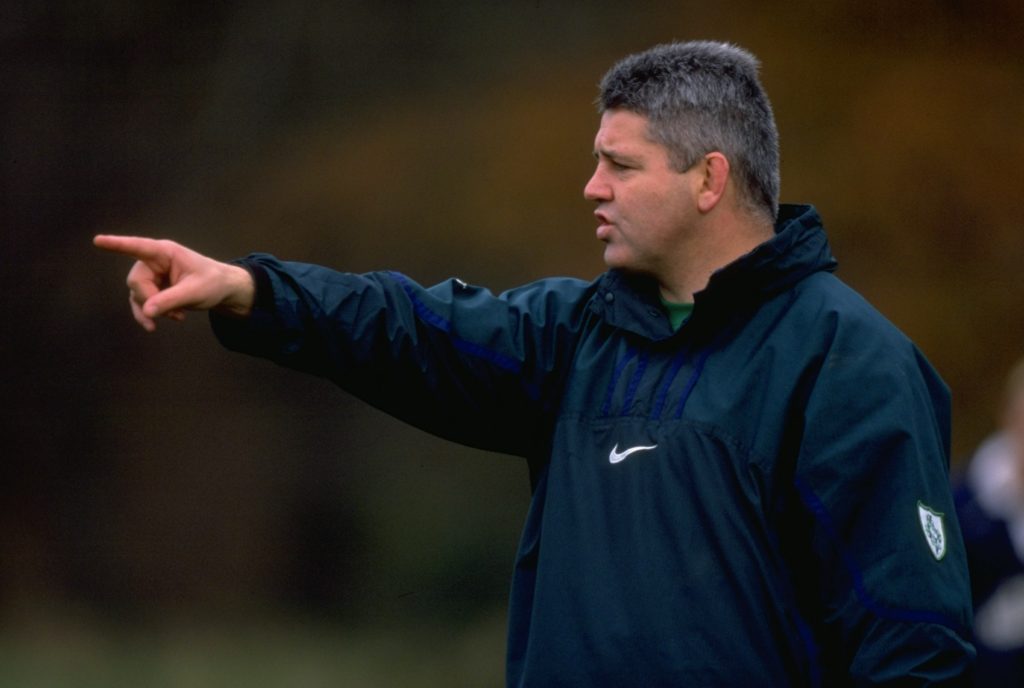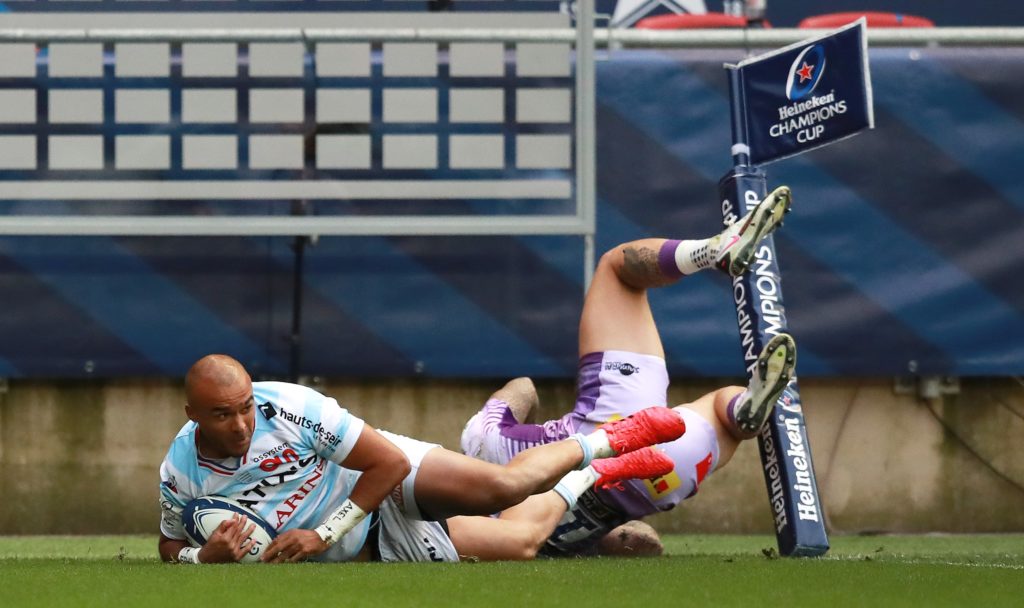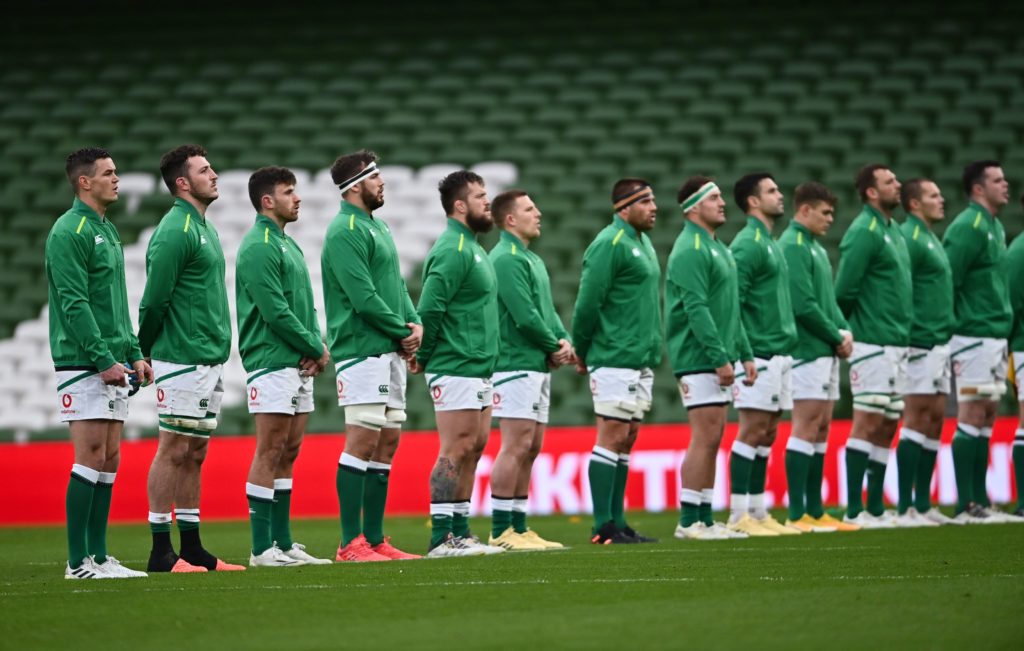To those looking back through green-tinted glasses, the 1991 World Cup will forever be remembered for Gordon Hamilton’s late try and Michael Lynagh’s even later one. It was a sliding-doors moment. Ireland – who have still to reach a World Cup semi-final – were moments away from eradicating their quarter-final curse, years before it had even woven its way into public consciousness.
Yet as close as Ireland were to victory against the eventual champion Wallabies on that quarter-final afternoon, they were just as close to not playing at all.
When Roly Meates, the chairman of the IRFU’s amateur status sub-committee, picked up the phone five nights before that game, the last thing he expected to hear was a declaration of war.
“Tell your friends on the union that Australia will run out and there’ll be no Ireland to play against them,” warned Des Fitzgerald, Ireland’s prop and de-facto union rep.
The dispute which threatened embarrassment on a global scale emanated from the spread of commercial revenue which had belatedly been allowed to trickle down to the players. That Ireland almost didn’t take the field for a World Cup quarter-final boiled down to nothing more than £1,500 a man. A point of principle carries its own value.
While the union eventually agreed to pay what was due, that they were willing to risk so much for so little, was indicative of their entrenched attitudes towards the concept of Irish internationals receiving any kind of financial recompense.
The fact the union were willing to risk so much for so little was indicative of their entrenched attitudes towards the concept of Irish internationals receiving any kind of financial recompense.
Against such a backdrop, it’s little wonder that the advent of professionalism just four years later would cause such consternation.
“It’s gone,” Lions legend and union representative Syd Millar was reported to have morbidly pronounced on August 27, 1995 as he strode across the lobby of Paris’s Ambassador Hotel after the seismic meeting of the International Rugby Board that confined the amateur game to the past.
With the implementation of a new reality beyond their control, such a momentous day in the sport’s history could have been a Road to Damascus moment for the IRFU blazers. Sadly not, Keith Wood’s subsequent battle over the expected blanket concession of his image rights three years later highlighting how some officials felt the modern professional only required a little walking around money to represent their country.
Even by 2020 standards, you’d have gotten long odds that 25 years on from that day in Paris, the relationship between the Ireland national side, its players, and its provinces, would be the envy of anyone, let alone so many.
So what changed?
At this juncture, it’s best to bring Warren Gatland into the discussion.

Before the Lions, before Waikato, Wasps and Wales, the decorated Kiwi was just a 34-year-old with two years coaching experience at Connacht on his CV.
Irish rugby, meanwhile, was a byword for crisis, changing coaches with the kind of speed Trump dispensed with his White House press officers. In this context, no one could have foreseen the impact Gatland would have when he was named Ireland coach one game into the 1998 Five Nations.
Not that all his early brainwaves were successful. Ahead of a Test against the fearsome Springboks in 1998, Gatland advised his players to apply fake tan to their pasty-coloured legs. “You’ll look hardier,” he told them. They lost 37-13.
Still, it didn’t stop Gatland thinking outside the box, and it didn’t take long for the former hooker to recognise the inherent lunacy of a system centered on Ireland’s best players being based in the English Premiership.
It didn’t take Gatland long to recognise the inherent lunacy of a system centred on Ireland’s best players being based in the English Premiership
While nothing was ever codified in black and white – Gatland delivered a significant policy shift in team selections, making it clear he would favour home-based talent ahead of players earning a living abroad.
The push to bring the first wave of Irish professionals back to the provinces was under way. Less than a year later, Ulster – who had won just two games in the competition prior to the 1998/99 campaign – were improbably crowned European champions after a recruitment drive saw David Humphreys, Mark McCall, Jonny Bell, Allen Clarke and Mark Blair return to Belfast.
The impending advent of the Celtic League in 2001 had quickened the inevitable march towards Leinster, Munster, Ulster and Connacht being viewed as professional operations rather than mere representative sides. And while it was still common to see a sizable number of internationals taking lumps out of each other for their All-Ireland League clubs on free weekends, that would soon feel as anachronistic as four points for a try.
Into this significantly altered landscape arrived what would quickly be dubbed Ireland’s ‘Golden Generation’. From the summer of 1999 through to the spring of 2002, Brian O’Driscoll, Gordon D’Arcy, Ronan O’Gara, Paul O’Connell, Shane Horgan, Peter Stringer and John Hayes all made their Test debuts. Having spent the previous decade as the Washington Generals to the Harlem Globetrotters of their rivals, the collective imagination of Irish Rugby would quickly run wild with previously unthinkable flights of fancy such as winning multiple games in the same season or finishing third in what was now the Six Nations.

Even when Gatland was shown the door – Eddie O’Sullivan coming in to replace him in 2001 – a belief in a largely home-based panel persisted. Having lost a jump on the English sides in the mid-90s, it was evident that more would have to be done to keep this cadre of talent in Ireland. Accordingly a pattern began which still exists to this day, whereby each autumn and winter, a steady stream of key men re-up terms to stay put. The idea of central contracts – frontline stars signing deals with the IRFU and essentially on secondment when representing their provinces – can offer a trio of advantages to the player that cannot be overcome by the greater financial rewards on offer further afield.
The first is simple geography. For a nation so famed for its diaspora, the comforts of home appear considerable to the Irish rugby player. The second is the strict management of game-time, with the cautionary tale of Johnny Sexton’s fatiguing schedule at Racing 92 still cited. And the third, perhaps most crucially but certainly most controversially, is the green jersey. While there were some notable exceptions prior to Joe Schmidt’s ascension to the top job in 2013, the likes of Leicester Tiger Geordan Murphy and Osprey Tommy Bowe among them, Sexton was the last player to feature for Ireland while plying his trade abroad -the 2018 World Player of the Year’s importance to the team granting him something of a special status not afforded to the likes of Simon Zebo, Donnacha Ryan, Ian Madigan and Marty Moore in the years since.
That the list of those who have departed from within the Irish Test bubble is so short – and that two of those aforementioned four have since returned – could cause one to draw conclusions on the balance of power in the negotiations.
Yet, Rob Kearney who will soon play outside of Ireland for a first time at the age of 34, believes the dynamic is often miscast.
“To be honest, the notion of the central contract can be overplayed,” says the preeminent Irish full-back of the pro era and most famous son of County Louth this side of Joe Biden.
“People think it guarantees you a place in the team and all sorts of things like that. I know from personal experience that’s not the case.
“What it boils down to is playing your rugby in Ireland. For me that has meant I’ve been a part of really successful teams and I’d always take that over a bigger contract elsewhere.
For me, playing rugby in Ireland has meant I’ve been a part of really successful teams and I’d always take that over a bigger contract elsewhere.
Rob Kearney.
“And then you’re very well looked after as well, you get those regeneration windows, and that’s very important in terms of the longevity of someone’s career.
“The union has the ownership of the players and can make sure that the players aren’t too fatigued during a season because they want them to play their best during the international windows but that’s good for the player as well. It means that you’re not playing 30-plus games a season like some of the English players because that has a huge knock-on to the longevity of your career. You get a few more years out of it when you’re on the other end.
“I think it’s mutually beneficial.”
It certainly has been. There are the outliers such as Zebo, and the opprobrium over who does and doesn’t get inked into the elite club generates the same outrage as any other selection between provincial rivals, but largely this has been a system good for both geese and gander.
Kearney, for example, departs these shores for Australia next year as Ireland’s most decorated player having been a part of two Grand Slams, two further Six Nations titles, four European Cups and six league-winning sides. The Irish Rugby team, and Irish rugby players, have enjoyed an unprecedented era of success, one unimaginable to their not-too-distant predecessors.

While provinces will occasionally still privately bristle at the surrendering of control over ‘their’ players, they need only look at recent comments from Exeter chairman Tony Rowe regarding England call-ups, or the continued clashes between Top 14 clubs and the FFR over regulation nine, to realise their lot falls firmly into the better-the-devil-you-know category. More to the point, the knock-on effect of the union picking up the tab for their most expensive assets is the key factor in subsequently having funds available for both the star imports at the top of their squads and the unmatched depth at the bottom that has aided recent domination of the PRO14.
In times of success like 2018 – when Ireland won a Grand Slam and Leinster the European Cup/PRO14 double – it can all feel like a virtuous circle, that the same men Gatland once described as viewing professionalism as “the work of the devil” somehow chanced upon a formula for success and those that followed continue to use it to beat the odds on an island where soccer as well as the indigenous sports of Gaelic football and hurling each lay claim to our best athletes.
Come 2020 however, and that blueprint has come to feel something like the Death Star – fearsome if only it weren’t for its one fatal flaw.
Irish Rugby’s whole system of operation in the professional era has been predicated on filling the Aviva Stadium at least five times a year. Fine in a time when the team’s popularity ensured that, almost unfathomably, the 2018 victories over England and New Zealand drew a larger TV audience than that year’s All-Ireland football and hurling finals. Fine, indeed, in almost any time other than that of an unforeseen pandemic that would bring the shutters down on the union’s primary asset.
Ah…
While the impact of Covid-19 upon the finances of the worldwide game has already been severe, few at the very highest level find their income streams so dependent upon bums on seats. In what is a trickle down economy, men’s rugby accounts for 96 cents of every euro the sport in Ireland generates. In strictly financial terms, Andy Farrell’s side isn’t so much the straw that stirs the drink but the entire beverage. Everything else can, at best, lay claim to the slice of lime.
In strictly financial terms, Andy Farrell’s side isn’t so much the straw that stirs the drink but the entire beverage. Everything else can, at best, lay claim to the slice of lime.
The organisation’s CEO Phillip Browne has overseen almost the entire professional era, taking on what was hardly an envied position in 1998 and playing his own part in the unlikely journey to where we sat in early February of this year, a time when the IRFU’s most recent accounts told of their best ever financial year. In a sport so often struggling to avoid the red elsewhere, the stewardship of Browne and honorary treasurer Tom Grace had brought in a surplus of €28 million.
Now, having already reported losses in excess of €30million and with worse yet to come, the picture darkens with every game played behind closed doors.
A former rower, Browne can recognise when a ship is taking on water at an unsustainable rate, his tone in recent months nothing short of apocalyptic.
“We simply can’t continue to operate on the basis of being dependent on the number of people we get through the stadium door and the ticket price we charge,” he told Newstalk’s Off The Ball radio programme back in May. “In the case of the Aviva stadium it is 51,000 [capacity] – that’s as big as it gets. You can’t make it any bigger and there is only so much elasticity in ticket prices that the public will bear.”

Already temporary pay cuts and a deferral scheme have been introduced – while some non-playing members of staff have been reduced to a four-day working week – but Browne has since told government officials that without some level of normality within the next 12 months, “drastically cut budgets” are inevitable. “The rugby infrastructure built over 150 years (in Ireland) is under threat.”
With the Irish Independent the first to report that central contract negotiations for next season had been placed on hold until greater clarity can be found – Johnny Sexton, Tadhg Furlong, CJ Stander, Iain Henderson, Keith Earls and Peter O’Mahony are among those on expiring deals – the system so often cited as a chief cause of Irish success is in danger of becoming unviable.
Whatever the morality of using the national jersey as a bargaining chip, it and all the other cards in your hand means little if you can’t even pull up a chair to the table. English and French clubs, not to mention those in Japan, whose financial models are less dependent on attendances have surely already had their interest piqued by the delay. Few, at this stage, could blame players for seeking assurances abroad which are presently unavailable at home.
As the Autumn Nations Cup continues this month, Browne will need little reminding that this low-key tournament is no aspirin for a uniquely 2020 headache.
Every empty seat in the Aviva Stadium is a reminder of what’s already been lost. And what’s still at stake.
More on Irish rugby
If you’ve enjoyed this article, please share it with friends or on social media. We rely solely on new subscribers to fund high-quality journalism and appreciate you sharing this so we can continue to grow, produce more quality content and support our writers.


Comments
Join free and tell us what you really think!
Sign up for free